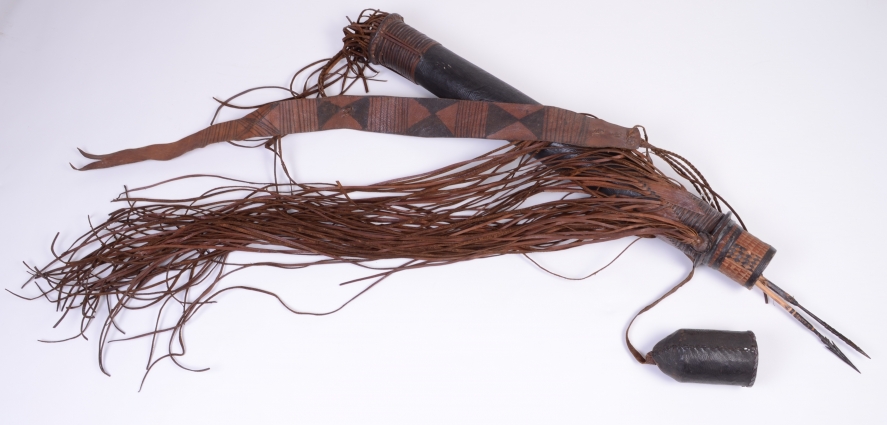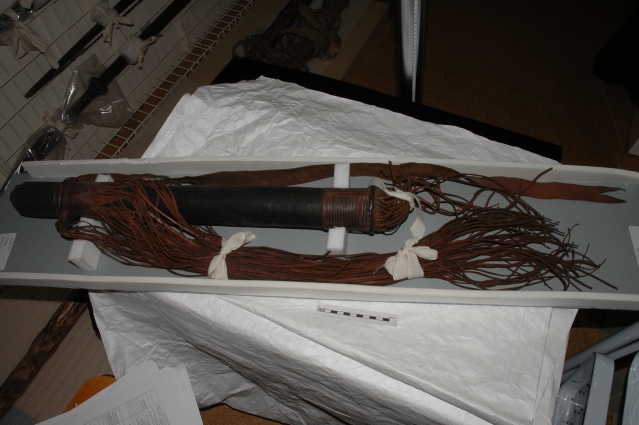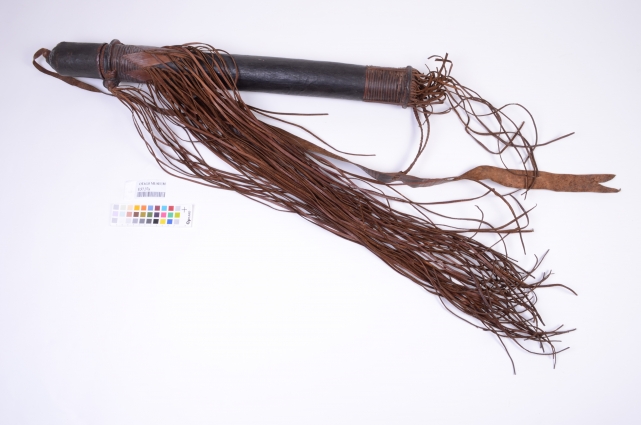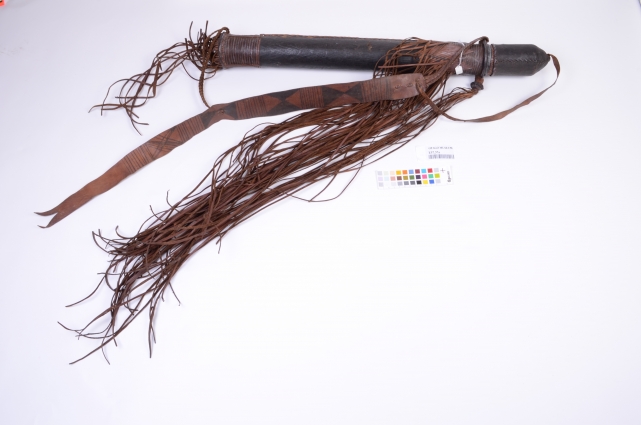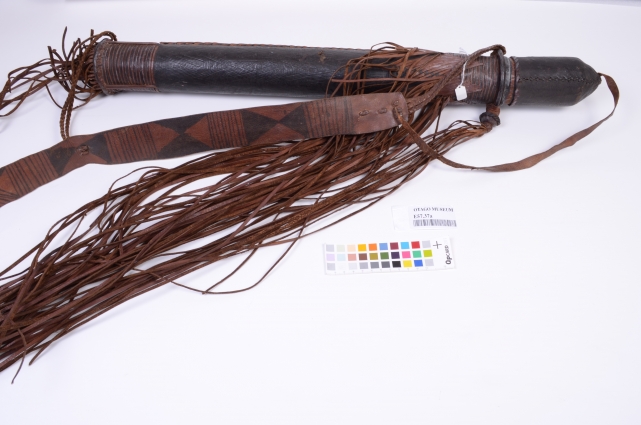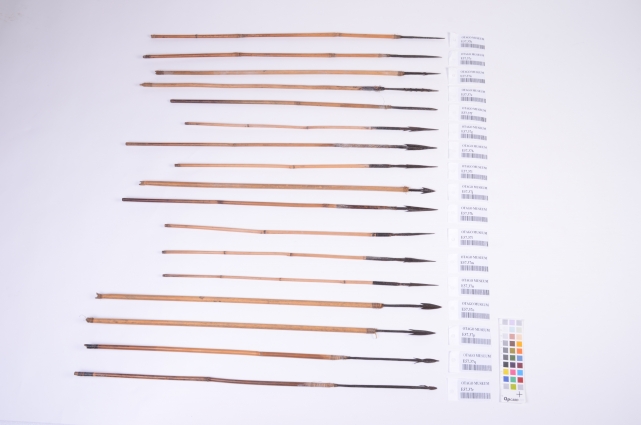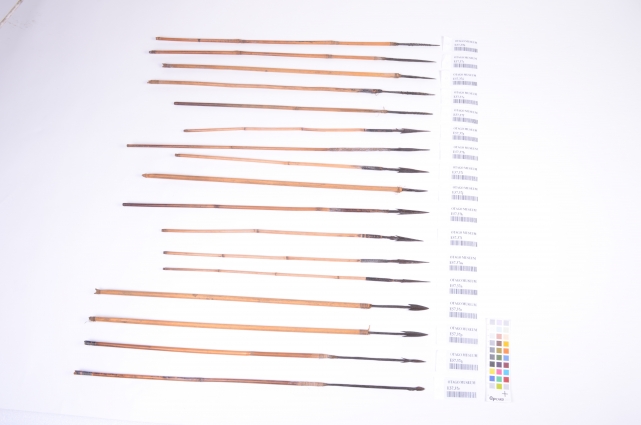Quiver, Arrow, E57.37
Physical Description
Quiver is a long, round cylinder covered in leather . Long leather decorative thongs hang from the side of the quiver extending well down below the base. A shoulder strap of leather with braiding at the top and near the bottom attaching strap to main body of quiver was used as strap over chest with quiver hanging along back of archer. A leather cap - a short cylinder open at one end and covered in leather, is attached to near top of shoulder strap with leather strap and is used to cover top of quiver. Main body of quiver appears to be a bamboo tube tightly wrapped in leather its full length with edges of leather sewn together with heavy leather cord the length of the quiver. The leather appears to have been dyed and dark red and then covered with a dark (black) ink/dye. The main body of quiver is of smooth leather mostly covered with impressed designs of multiple parallel lines of many directions. Both the top and bottom edges are wrapped with braids and strands of leather cord which extend well beyond length of quiver giving it a highly decorated and flowing appearance. The quiver cap is of a single piece of leather with its edges neatly sewn together with animal sinew(?). The edges are brought together at the top end to form a somewhat rounded point, through which a strong leather strap has been placed and knotted with the main body of the strap continuing down some distance before tying in to the shoulder strap. Thus if cap (to protect arrows/or prevent their loss) is removed it remains attached to the quiver by the shoulder strap. The bottom edge of the cap is sewn the circumference with heavy leather thong. The top end of the quiver, over which the cap is placed, is decorated with a series of diamond and triangle patterns of red, black, and natural leather. It appears these patterns have been formed by excising the surface of the leather. A heavy leather collar runs the circumference of the quiver immediately below the lower extent of the cap. Through this collar three long braided strands run which are in turn attached to one end of a long narrow flat strap of leather. This flat leather strap is the shoulder strap. Approximately half way down the length of this strap two braided strands of leather are attached which in turn are attached to a heavy leather collar which extends the circumference of the quiver at its very base. The leather shoulder strap appears to have been dyed a dark red over which a series of lines and triangles of black ink/dye have been painted. The general appearance of the quiver is of a highly decorated, skilfully made item, using well tanned leather. The quiver may have received some use but is in good condition. The quiver contains 17 arrows of various lengths, diameters each with a iron point (hand forged?) with its long metal shaft inserted into one end of a bamboo/wooden stick. The ends of the bamboo/wooden shafts are wrapped round with animal sinew(?) in some instances and with plant(?) fibre in others. The opposite end of the bamboo/wooden shafts are notched and wrapped with plant fibre/animal sinew in some instances and in other instances they are unnotched and unwrapped. Arrows are not fletched, i.e. no feathers. Three of the arrows have very narrow points with multiple tangs - frequently considered for shooting fish. One arrow has a very long narrow point with no tangs. This particular arrow and several others appear to be covered with a resin or some other matter (preservative?). The remaining arrows have classic double tanged iron heads of varying lengths and widths. Five of the arrows shafts appear to be of wood or tree branch(?) with the remaining 12 appearing to be of bamboo.
Research Notes
Africa Collection File:
Quiver, wood, leather tassels, with arrows
(W. Nigeria) —Sarah Brodie
Quiver, wood, leather tassels, with arrows
(W. Nigeria) —Sarah Brodie
Hausa/Fulani(?)
"Africa Collection File" (Otago Museum) by Sarah Brodie says, "Pres.F.F.A. Ulrich from the estate of his late brother G.A.C. Ulrich B.Sc., AOSM (3rd son of the late Northern Nigeria, Ilorin Province (?). Prof Ulrich, one time curator of O.M.) 1898-1912 mining in Tasmania, Australia & NZ; 1913-14 Gold Coast ; 1919-24 Asante goldfields; 1925-26 Taguaka Abosso (?) Gold Mining Co. Ltd.; 1927-28 general prospecting in Nigeria, Illorin Province, Tui & Mica (?) Died 1956, NZ Leather (sheep/goat?), iron, wood, bamboo, sinew.
Quiver for holding ding arrows. Arrows for hunting (small game and fish). Hausa and Fulani were/are excellent horsemen. Quivers of this type were likely used by horsemen in war. Today such quivers are mostly used for show/ceremonies and sold to tourists. The arrows are still made for use in hunting/fishing.
Quiver is a long, round cylinder covered in leather. Long leather decorative thongs hang from the side of the quiver extending well down below the base. A shoulder strap of leather with braiding at the top and near the bottom attaching strap to main body of quiver was used as strap over chest with quiver hanging along back of archer. A leather cap - a short cylinder open at one end and covered in leather, is attached to near top of shoulder strap with leather strap and is used to cover top of quiver. Main body of quiver appears to be a bamboo tube tightly wrapped in leather its full length with edges of leather sewn together with heavy leather cord the length of the quiver. The leather appears to have been dyed and dark red and then covered with a dark (black) ink/dye. The main body of quiver is of smooth leather mostly covered with impressed designs of multiple parallel lines of many directions. Both the top and bottom edges are wrapped with braids and strands of leather cord which extend well beyond length of quiver giving it a highly decorated and flowing appearance. The quiver cap is of a single piece of leather with its edges neatly sewn together with animal sinew(?). The edges are brought together at the top end to form a somewhat rounded point, through which a strong leather strap has been placed and knotted with the main body of the strap continuing down some distance before tying in to the shoulder strap. Thus if cap (to protect arrows/or prevent their loss) is removed it remains attached to the quiver by the shoulder strap. The bottom edge of the cap is sewn the circumference with heavy leather thong. The top end of the quiver, over which the cap is placed, is decorated with a series of diamond and triangle patterns of red, black, and natural leather. It appears these patterns have been formed by excising the surface of the leather. A heavy leather collar runs the circumference of the quiver immediately below the lower extent of the cap. Through this collar three long braided strands run which are in turn attached to one end of a long narrow flat strap of leather. This flat leather strap is the shoulder strap. Approximately half way down the length of this strap two braided strands of leather are attached which in turn are attached to a heavy leather collar which extends the circumference of the quiver at its very base. The leather shoulder strap appears to have been dyed a dark red over which a series of lines and triangles of black ink/dye have been painted. The general appearance of the quiver is of a highly decorated, skilfully made item, using well tanned leather. The quiver may have received some use but is in good condition. The quiver contains 17 arrows of various lengths, diameters each with a iron point (hand forged?) with its long metal shaft inserted into one end of a bamboo/wooden stick. The ends of the bamboo/wooden shafts are wrapped round with animal sinew(?) in some instances and with plant(?) fibre in others. The opposite end of the bamboo/wooden shafts are notched and wrapped with plant fibre/animal sinew in some instances and in other instances they are unnotched and unwrapped. Arrows are not fletched, i.e. no feathers. Three of the arrows have very narrow points with multiple tangs - frequently considered for shooting fish. One arrow has a very long narrow point with no tangs. This particular arrow and several others appear to be covered with a resin or some other matter (preservative?). The remaining arrows have classic double tanged iron heads of varying lengths and widths. Five of the arrows shafts appear to be of wood or tree branch(?) with the remaining 12 appearing to be of bamboo. NOTE: NONE OF THE ARROWS HAVE A REGISTRATION/CATALOGUE NUMBER.
Quiver length without cap & leather fringes = approx. 610mm. Length of cap = approx. 116mm. diameter of quiver (ED) = approx. 65mm. Length of shoulder strap from quiver attachment to strap end = approx. 1010mm. Length of decorative thongs = approx. 900mm. Length of arrows runs between 485 mm and 603 mm.
"Africa Collection File" (Otago Museum) by Sarah Brodie says, "Pres.F.F.A. Ulrich from the estate of his late brother G.A.C. Ulrich B.Sc., AOSM (3rd son of the late Northern Nigeria, Ilorin Province (?). Prof Ulrich, one time curator of O.M.) 1898-1912 mining in Tasmania, Australia & NZ; 1913-14 Gold Coast ; 1919-24 Asante goldfields; 1925-26 Taguaka Abosso (?) Gold Mining Co. Ltd.; 1927-28 general prospecting in Nigeria, Illorin Province, Tui & Mica (?) Died 1956, NZ Leather (sheep/goat?), iron, wood, bamboo, sinew.
Quiver for holding ding arrows. Arrows for hunting (small game and fish). Hausa and Fulani were/are excellent horsemen. Quivers of this type were likely used by horsemen in war. Today such quivers are mostly used for show/ceremonies and sold to tourists. The arrows are still made for use in hunting/fishing.
Quiver is a long, round cylinder covered in leather. Long leather decorative thongs hang from the side of the quiver extending well down below the base. A shoulder strap of leather with braiding at the top and near the bottom attaching strap to main body of quiver was used as strap over chest with quiver hanging along back of archer. A leather cap - a short cylinder open at one end and covered in leather, is attached to near top of shoulder strap with leather strap and is used to cover top of quiver. Main body of quiver appears to be a bamboo tube tightly wrapped in leather its full length with edges of leather sewn together with heavy leather cord the length of the quiver. The leather appears to have been dyed and dark red and then covered with a dark (black) ink/dye. The main body of quiver is of smooth leather mostly covered with impressed designs of multiple parallel lines of many directions. Both the top and bottom edges are wrapped with braids and strands of leather cord which extend well beyond length of quiver giving it a highly decorated and flowing appearance. The quiver cap is of a single piece of leather with its edges neatly sewn together with animal sinew(?). The edges are brought together at the top end to form a somewhat rounded point, through which a strong leather strap has been placed and knotted with the main body of the strap continuing down some distance before tying in to the shoulder strap. Thus if cap (to protect arrows/or prevent their loss) is removed it remains attached to the quiver by the shoulder strap. The bottom edge of the cap is sewn the circumference with heavy leather thong. The top end of the quiver, over which the cap is placed, is decorated with a series of diamond and triangle patterns of red, black, and natural leather. It appears these patterns have been formed by excising the surface of the leather. A heavy leather collar runs the circumference of the quiver immediately below the lower extent of the cap. Through this collar three long braided strands run which are in turn attached to one end of a long narrow flat strap of leather. This flat leather strap is the shoulder strap. Approximately half way down the length of this strap two braided strands of leather are attached which in turn are attached to a heavy leather collar which extends the circumference of the quiver at its very base. The leather shoulder strap appears to have been dyed a dark red over which a series of lines and triangles of black ink/dye have been painted. The general appearance of the quiver is of a highly decorated, skilfully made item, using well tanned leather. The quiver may have received some use but is in good condition. The quiver contains 17 arrows of various lengths, diameters each with a iron point (hand forged?) with its long metal shaft inserted into one end of a bamboo/wooden stick. The ends of the bamboo/wooden shafts are wrapped round with animal sinew(?) in some instances and with plant(?) fibre in others. The opposite end of the bamboo/wooden shafts are notched and wrapped with plant fibre/animal sinew in some instances and in other instances they are unnotched and unwrapped. Arrows are not fletched, i.e. no feathers. Three of the arrows have very narrow points with multiple tangs - frequently considered for shooting fish. One arrow has a very long narrow point with no tangs. This particular arrow and several others appear to be covered with a resin or some other matter (preservative?). The remaining arrows have classic double tanged iron heads of varying lengths and widths. Five of the arrows shafts appear to be of wood or tree branch(?) with the remaining 12 appearing to be of bamboo. NOTE: NONE OF THE ARROWS HAVE A REGISTRATION/CATALOGUE NUMBER.
Quiver length without cap & leather fringes = approx. 610mm. Length of cap = approx. 116mm. diameter of quiver (ED) = approx. 65mm. Length of shoulder strap from quiver attachment to strap end = approx. 1010mm. Length of decorative thongs = approx. 900mm. Length of arrows runs between 485 mm and 603 mm.
Provenance
Measurements
Maximum dimensions (H x W x D) (a - Quiver): 1050 x 250 x 110mmMaximum dimensions (H x W x D) (b - Arrow 1): 605 x 10 x 10mm
Maximum dimensions (H x W x D) (c - Arrow 2): 605 x 9 x 8mm
Maximum dimensions (H x W x D) (d - Arrow 3): 572 x 8 x 9mm
Maximum dimensions (H x W x D) (e - Arrow 4): 573 x 8 x 8mm
Maximum dimensions (H x W x D) (f - Arrow 5): 525 x 8 x 7mm
Maximum dimensions (H x W x D) (g - Arrow 6): 485 x 11 x 5mm
Maximum dimensions (H x W x D) (h - Arrow 7): 595 x 12 x 7mm
Maximum dimensions (H x W x D) (i - Arrow 8): 491 x 11 x 7mm
Maximum dimensions (H x W x D) (j - Arrow 9): 547 x 13 x 10mm
Maximum dimensions (H x W x D) (k - Arrow 10): 579 x 11 x 7mm
Maximum dimensions (H x W x D) (l - Arrow 11): 498 x 11 x 6mm
Maximum dimensions (H x W x D) (m - Arrow 12): 486 x 9 x 5mm
Maximum dimensions (H x W x D) (n - Arrow 13): 485 x 10 x 6mm
Maximum dimensions (H x W x D) (o - Arrow 14): 605 x 14 x 9mm
Maximum dimensions (H x W x D) (p - Arrow 15): 602 x 15 x 9mm
Maximum dimensions (H x W x D) (q - Arrow 16): 602 x 12 x 8mm
Maximum dimensions (H x W x D) (r - Arrow 17): 608 x 8 x 7mm
All Rights Reserved

